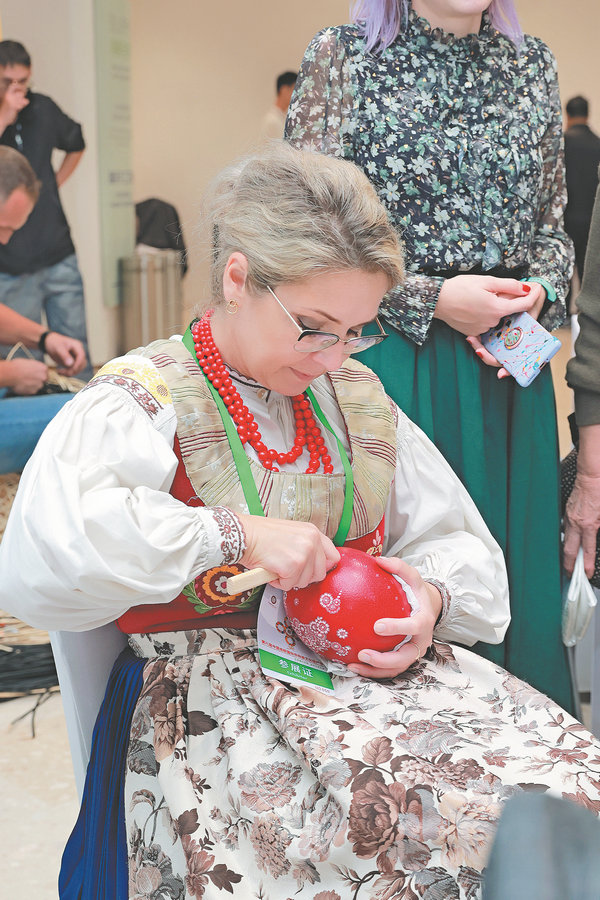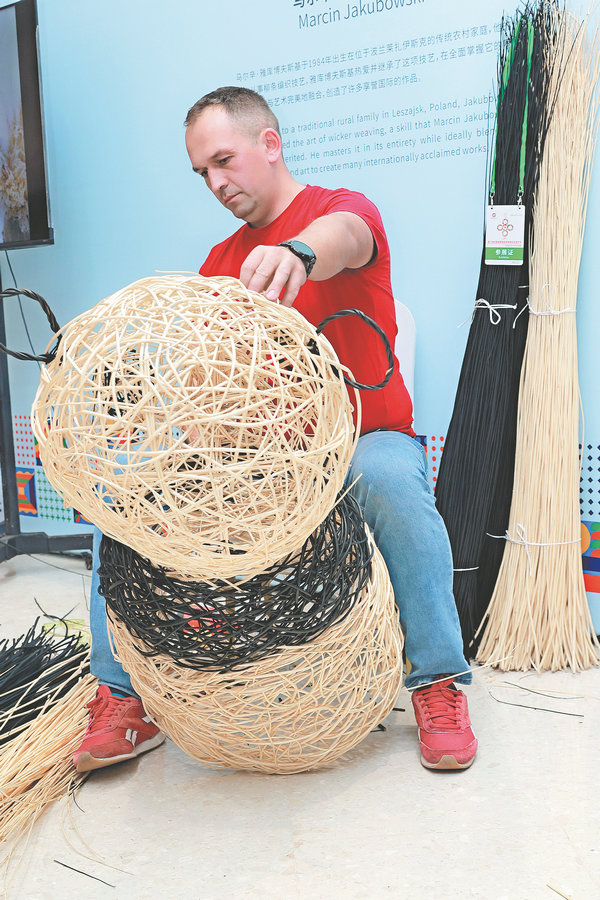
Adriaan Rees, a visual artist from Amsterdam, the Netherlands, delivered two sculpture artworks that are imprinted with Chinese elements.
One work features a woman with her face in a bucket that bears the Chinese character meaning "double happiness", and the other sculpture he made is characteristic of painted patterns of auspicious Chinese images, ranging from peach blossoms to peony flowers.
"They are all from a dream and a show of my imagination," Rees says.
He came to Jingdezhen in southeastern Jiangxi province more than two decades ago, because it is considered to be the birthplace of porcelain, something that has long fascinated him.
"I love Jingdezhen so much, because, at that time, there weren't many artists, just craftsmen, so I could ask them to help me with my work, and thus combine Eastern elements into my art," Rees says.
"I have had my studio in Jingdezhen, because in China there are techniques and materials we don't have in Holland, so it has a totally different influence on my works," Rees adds.
In addition to porcelain, Rees says he has also been drawn to traditional Chinese embroidery.
"I'd like to apply Chinese textiles to my works, but it will take some time," Rees says.

A stone's throw from Rees' artworks, across the pavilion, Grazyna Fila from Poland is surrounded by curious visitors examining her stunning egg carvings.
The polish Easter Egg master carver is known for applying ingenious patterns to eggshells, featuring traditional floral and lace motifs from Poland.
In 2021, she created one of the world's largest decorated egg artworks, she says.
At the Chengdu festival, the giant panda made its way into her work, appearing on eggs of various sizes through her creative touch.
"Those eggs are commonly used as a decoration for our Easter," Fila says.
The eggs are usually steeped in pigments and dyed, before the artist carves out the patterns.
In addition to meticulously applying appropriate pressure to the thin eggshells, muscle pain from the long hours of holding the eggs and the sculpting tool is among the major challenges behind the feat, she explains.
It's her first time visiting Chengdu, so she chose the panda as her subject, as part of her effort to endear her craft to her Chinese hosts.
"I used the treasure of Chengdu, the panda, and added distinctive polish flowers on one egg, so it sort of brings together two cultures," Fila says.
During the festival, she was thrilled to see many people took interest in her work and wanted to buy some of her decorated eggs.
She says she will explore more Chinese elements in the future.

Right next to her, Polish wicker weaving artist Marcin Jakubowski attracted attention as a cute giant panda head made of wicker took shape in his hands.
"As long as I see something, I can present it through wicker," Jakubowski says, adding that he wants the festival participants to see that wicker can be used to create many forms of art and objects of use, including furniture.
In the Serbia section, a replica of the crown of Serbian King Stefan Uros Milutin Nemanjic (1282-1321) was displayed right next to a replica of the phoenix crown of Empress Xiaoduan of the Ming Dynasty (1368-1644).
"Chinese silver filigree has as specific a style as that of Serbian silverwork, but in general, they both use very intricate and fine silver wires and lots of handwork," says Goran Ristovic from Serbia. He has studied the filigree craft for more than two decades and has made many intricately shaped and delicate works.
The Serbian crown has a domelike shape, which is very similar to the Chinese phoenix crown, he explains.
Similarities between the two can also be found in the way the silver wires are twisted together, as well as the hammering, chiseling and the decorative stones, according to Ristovic.
"We are proud to present some Serbian filigree products together with Chinese artworks. We hope to establish cooperation with Chinese artists in the field," Ristovic says.
He notes that many ancient items, such as silks and porcelain, made their way from China to his country through the Silk Road.
"There is a great Chinese cultural influence on our country," he says.
Beginning at the end of the 13th century, filigree was introduced to Serbia under Byzantine influence and became one of the most common crafts used in the process of making gold and silver jewelry there. It was often used to create ceremonial objects in a luxurious and exquisite style.
To some extent, intangible cultural heritage is a language that transcends borders, says Zhang Jingming, curator of the international traditional handicrafts exhibition.
The display of all the cultural heritage together is a great way of narrating the common development of craftsmanship beyond borders, and visually expresses the cultural integration and commonality along the Silk Road, Zhang says.